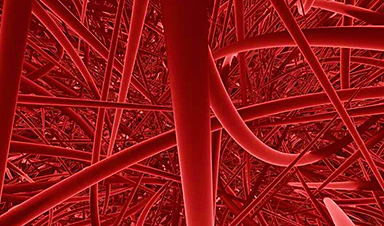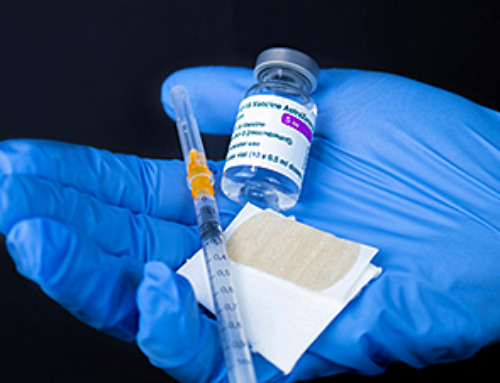Biological computing machines, such as micro and nano-implants that can collect important information inside the human body, are transforming medicine. Yet, networking them for communication has proven challenging. Now, a global team, including EPFL researchers, has developed a protocol that enables a molecular network with multiple transmitters.
“Overall, this is a very, very exciting research field,” explained Assistant Professor Haitham Al Hassanieh, head of the Laboratory of Sensing and Networking Systems in EPFL’s School of Computer and Communication Sciences (IC). “With advances in bio-engineering, synthetic biology, and nanotechnology, the idea is that nano-biosensors will revolutionize medicine because they can reach places and do things that current devices or larger implants can’t,” he continued.
Yet no matter how exciting this cutting-edge research field is, there remains a huge, fundamental challenge—when you have a nano-robot in someone’s body, how will you communicate with it? Traditional techniques, like wireless radios, work well for large implants such as pacemakers or defibrillators but can’t be scaled to micro and nano-dimensions, and wireless signals don’t penetrate through body fluids.
Enter what’s being called biomolecular communication, inspired by the body itself. It doesn’t utilize electromagnetic waves but biological molecules both as carriers and as information, mimicking the existing communication mechanisms in biology. In its simplest form it encodes “1” and “0” bits by releasing or not releasing molecular particles into the bloodstream—similar to ON-OFF-Keying in wireless networks.
“Biomolecular communication has emerged as the most suitable paradigm for networking nano-implants. It’s an incredible idea that we can send data by encoding it into molecules which then go through the bloodstream and we can communicate with them, guiding them on where to go and when to release their treatments, just like hormones,” Al Hassanieh said.
Recently, Al Hassanieh and his team, in collaboration with researchers in the United States presented their paper, “Towards Practical and Scalable Molecular Networks,” at ACM SIGCOMM 2023, an annual conference on Data Communication, in which they outlined their MoMA (Molecular Multiple Access) protocol that enables a molecular network with multiple transmitters.
“Most existing research is very theoretical and doesn’t work because the theories haven’t considered biology,” explained Al Hassanieh. “For example, every time the heart pumps there’s a jitter and the body changes its internal communication channel. Most existing theory assumes that the channel that you send the molecules over is very stable and doesn’t change. It actually changes very fast.”
With MoMA, the team introduced packet detection, channel estimation, and encoding/decoding schemes that leverage the unique properties of molecular networks to address existing challenges. They evaluated the protocol on a synthetic experimental testbed—emulated blood vessels with tubes and pumps—demonstrating that it can scale up to four transmitters while significantly outperforming state-of-the-art technology.
The researchers acknowledge that their current synthetic testbed may not capture all the challenges associated with designing protocols for molecular networks and that in-vivo testing of micro-implants and micro-fluids in wet-labs is needed to achieve practical and deployable molecular networks. However, they believe they have taken the first steps towards this vision and that their insights for designing molecular networks will hold, as the underlying diffusion and fluid dynamics models in their testbed are fundamental to molecular communication
“I am very excited about this area because it’s a new form of communication. We are a systems group, we like building things and getting them working. It’s taken time to develop the expertise we have in biomolecular communication but now we are at the stage where we are finding collaborators and can get things moving. People think this is science fiction but it’s fast moving to science fact,” Al Hassanieh concluded.
More information: Jiaming Wang et al, Towards Practical and Scalable Molecular Networks, Proceedings of the ACM SIGCOMM 2023 Conference (2023). DOI: 10.1145/3603269.3604881
News
Scientists Unlock a New Way to Hear the Brain’s Hidden Language
Scientists can finally hear the brain’s quietest messages—unlocking the hidden code behind how neurons think, decide, and remember. Scientists have created a new protein that can capture the incoming chemical signals received by brain [...]
Does being infected or vaccinated first influence COVID-19 immunity?
A new study analyzing the immune response to COVID-19 in a Catalan cohort of health workers sheds light on an important question: does it matter whether a person was first infected or first vaccinated? [...]
We May Never Know if AI Is Conscious, Says Cambridge Philosopher
As claims about conscious AI grow louder, a Cambridge philosopher argues that we lack the evidence to know whether machines can truly be conscious, let alone morally significant. A philosopher at the University of [...]
AI Helped Scientists Stop a Virus With One Tiny Change
Using AI, researchers identified one tiny molecular interaction that viruses need to infect cells. Disrupting it stopped the virus before infection could begin. Washington State University scientists have uncovered a method to interfere with a key [...]
Deadly Hospital Fungus May Finally Have a Weakness
A deadly, drug-resistant hospital fungus may finally have a weakness—and scientists think they’ve found it. Researchers have identified a genetic process that could open the door to new treatments for a dangerous fungal infection [...]
Fever-Proof Bird Flu Variant Could Fuel the Next Pandemic
Bird flu viruses present a significant risk to humans because they can continue replicating at temperatures higher than a typical fever. Fever is one of the body’s main tools for slowing or stopping viral [...]
What could the future of nanoscience look like?
Society has a lot to thank for nanoscience. From improved health monitoring to reducing the size of electronics, scientists’ ability to delve deeper and better understand chemistry at the nanoscale has opened up numerous [...]
Scientists Melt Cancer’s Hidden “Power Hubs” and Stop Tumor Growth
Researchers discovered that in a rare kidney cancer, RNA builds droplet-like hubs that act as growth control centers inside tumor cells. By engineering a molecular switch to dissolve these hubs, they were able to halt cancer [...]
Platelet-inspired nanoparticles could improve treatment of inflammatory diseases
Scientists have developed platelet-inspired nanoparticles that deliver anti-inflammatory drugs directly to brain-computer interface implants, doubling their effectiveness. Scientists have found a way to improve the performance of brain-computer interface (BCI) electrodes by delivering anti-inflammatory drugs directly [...]
After 150 years, a new chapter in cancer therapy is finally beginning
For decades, researchers have been looking for ways to destroy cancer cells in a targeted manner without further weakening the body. But for many patients whose immune system is severely impaired by chemotherapy or radiation, [...]
Older chemical libraries show promise for fighting resistant strains of COVID-19 virus
SARS‑CoV‑2, the virus that causes COVID-19, continues to mutate, with some newer strains becoming less responsive to current antiviral treatments like Paxlovid. Now, University of California San Diego scientists and an international team of [...]
Lower doses of immunotherapy for skin cancer give better results, study suggests
According to a new study, lower doses of approved immunotherapy for malignant melanoma can give better results against tumors, while reducing side effects. This is reported by researchers at Karolinska Institutet in the Journal of the National [...]
Researchers highlight five pathways through which microplastics can harm the brain
Microplastics could be fueling neurodegenerative diseases like Alzheimer's and Parkinson's, with a new study highlighting five ways microplastics can trigger inflammation and damage in the brain. More than 57 million people live with dementia, [...]
Tiny Metal Nanodots Obliterate Cancer Cells While Largely Sparing Healthy Tissue
Scientists have developed tiny metal-oxide particles that push cancer cells past their stress limits while sparing healthy tissue. An international team led by RMIT University has developed tiny particles called nanodots, crafted from a metallic compound, [...]
Gold Nanoclusters Could Supercharge Quantum Computers
Researchers found that gold “super atoms” can behave like the atoms in top-tier quantum systems—only far easier to scale. These tiny clusters can be customized at the molecular level, offering a powerful, tunable foundation [...]
A single shot of HPV vaccine may be enough to fight cervical cancer, study finds
WASHINGTON -- A single HPV vaccination appears just as effective as two doses at preventing the viral infection that causes cervical cancer, researchers reported Wednesday. HPV, or human papillomavirus, is very common and spread [...]





















